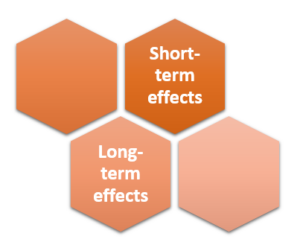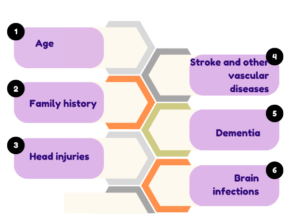Between 4 and 10 persons per 1000 are thought to have active epilepsy at any given time in the general population. Seizure prevalence and incidence studies are becoming more and more prevalent, especially in low- and middle-income nations. Common seizure symptoms and their causes are very much important for people to know for the eradication or prevention of the disease.
Epilepsy prevalence and incidence estimates vary widely around the globe, possibly due to disparities in measurement and reporting as well as clinical traits like etiology and seizure type.
A seizure is a sudden change in behavior or awareness brought on by a change in the brain’s electrical activity. When you have epilepsy, your risk of sudden, unprovoked seizures increases. This article describes the common seizure symptoms and their causes, risk factors and prevention tips.
What is a Seizure?
An uncontrolled, rapid spike in brain activity is known as a seizure. It can alter consciousness levels, as well as behavior, movement, and feelings. Epilepsy is defined as two or more unprovoked seizures that occur at least 24 hours apart. Strokes and brain injuries can result in seizures.
They might also be brought on by a disease or an infection like meningitis. However, the cause is frequently not known. The common seizure symptoms and their causes are what is important for knowing about the severity of the patient.
When you have epilepsy, your risk of sudden, unprovoked seizures increases. When a patient has at least two unprovoked seizures or one unprovoked seizure with a significant likelihood of having at least one more in the near future, medical professionals diagnose it. They can vary widely in their presentation and severity, but there are some common seizure symptoms and their causes that are sometimes patient-specific.
Common Seizure Symptoms and Their Causes
Several types of symptoms are associated with this disease. Major symptoms include:
- Temporary confusion.
- Jerking movements of the arms and legs that can’t be controlled.
- Loss of consciousness or awareness.
- Cognitive or emotional changes. They may include fear, anxiety, or a feeling
Seizures are categorized as either focal or generalized, based on how and where the brain activity causing the seizure begins. The common seizure symptoms and their causes are varying on several patients.
When seizures appear to result from activity in just one area of the brain, they’re known as focal seizures. These seizures fall into two categories:
- Focal seizures without loss of consciousness– These seizures, which were once known as simple partial seizures, don’t result in a loss of awareness, commonly known as consciousness. They may modify feelings or affect how objects appear, feel, sound, or smell. Additionally, sensory symptoms including tingling, vertigo, and flashing lights can be brought on by focal seizures.
- Focal seizures with impaired awareness– These seizures, which were once known as complex partial seizures, include a shift or loss of consciousness. This kind of seizure could make you feel like you’re dreaming. Additionally, they could do repetitive movements like rubbing their hands together, eating, swallowing, or walking in circles.
Generalized Seizures
Seizures that appear to involve all areas of the brain are called generalized seizures. It has different types and these several kinds involve multiple symptoms that are somewhat different from each other.
- Absence seizures– Symptoms involve staring into space with or without subtle body movements. Movements may include eye blinking or lip smacking and only last 5 to 10 seconds.
- Tonic seizures– These seizures cause stiff muscles and may affect consciousness. These seizures generally affect muscles in the back, arms, and legs and may cause the person to fall to the ground.
- Atonic seizures– Also known as drop seizures, cause a loss of muscle control. Since this most often affects the legs, it often causes sudden falls to the ground.
- Clonic seizures– These seizures are associated with repeated or rhythmic jerking muscle movements. These seizures usually affect the neck, face, and arms.
- Myoclonic seizures– They generally appear as sudden brief jerks or twitches and usually affect the upper body, arms, and legs.
- Tonic-clonic seizures– These previously known as grand mal seizures, are the most dramatic type of epileptic seizure. They can cause a sudden loss of consciousness and body stiffening, twitching, and shaking.
What Are The Effects of Seizures Symptoms?
Living with epilepsy and experiencing repeated seizures can have both short- and long-term effects. These can range from a drop in quality of life to increased risks of mental health conditions.

-
Short-term effects
You might become completely unable to control your body during some seizures. Falls and other motions as a result of this may cause injuries. People with epilepsy frequently experience greater physical problems than those without the disorder, such as fractures and bruising.
Your quality of life may suffer if you are prone to seizures. You might no longer be able to drive, for example. You might wish to stay away from activities like swimming or solo travel where a seizure could be dangerous.
-
Long-term effects
Seizure symptoms may worsen and gradually continue longer if you don’t receive therapy. Long-lasting seizures may result in coma or death. Although epilepsy-related deaths are uncommon, the risk of premature death is up to three times higher in those with epilepsy than in the general population.
Your mental health may be impacted by having epilepsy. The fear of having a seizure can cause depression or anxiety in people with epilepsy. Additionally, they might feel alone, fear harm, or encounter stigma.
Risk Factors of Seizures
Certain factors may increase your risk of seizures:

1. Age– The onset of epilepsy is most common in children and older adults, but the condition can occur at any age.
2. Family history– If you have a family history of epilepsy, you may be at an increased risk of seizures.
3. Head injuries– Some cases of epilepsy are caused by head injuries. By using a seat belt when driving, you can lower your risk. When biking, skiing, riding a motorbike, or engaging in any other activity that carries a significant risk of head injury, you should also wear a helmet.
4. Stroke and other vascular diseases– Brain injury can be brought on by blood vessel conditions like stroke. Epilepsy and seizures may be brought on by brain injury. You can take action to lower your risk of contracting certain illnesses. Drink in moderation, don’t smoke, eat well, and work out frequently.
5. Dementia– Dementia can increase the risk of epilepsy in older adults.
6. Brain infections– Infections such as meningitis, which causes inflammation in the brain or spinal cord, can increase your risk.
People also like to read: What is Epilepsy?
Know About the Causes of Seizures Symptoms
Electrical impulses are produced, sent, and received by neurons, which are nerve cells in the brain. The cells can now communicate as a result. A seizure may result from anything that obstructs the communication routes. Genetic alterations may be the root cause of certain seizure types. Different common seizure symptoms and their causes indicate specifically the type of treatment that one has to undergo.
Each person’s epilepsy has a unique cause, and some people have no known cause at all. Others have epilepsy that can be directly linked to genetics, brain damage, autoimmune diseases, metabolic problems, or infectious infections. The common seizure symptoms and their causes vary depending on the circumstance.
Infections–
Infection is probably the most common cause of epilepsy worldwide. If there is proof of a brain infection that leads to seizures, this is considered an infectious cause of epilepsy. Meningitis, HIV, viral encephalitis, and some parasitic infections can cause epilepsy.
Autoimmune Epilepsy–
Your immune system protects your body from foreign substances and other things that could hurt it. Autoimmune epilepsy (AE) is caused by a change in your body’s immune function.
Genetic Factors–
Some types of epilepsy are inherited from one generation to the next and run in families. Other forms of epilepsy may result from inherited genetic abnormalities that are manifesting for the first time. Certain epilepsy kinds have been linked by researchers to particular genes. However, not all cases of genetic epilepsy are inherited. A child’s genes can change even if they are not inherited from their parents. Genes only account for a portion of epilepsy in the majority of cases.
Metabolic Causes–
Your body contains enzymes that are responsible for processing the food you eat. If there is a problem in one of these enzymes, this can lead to issues breaking down food or making the energy your body needs to function.
Developmental conditions–
Epilepsy can occasionally coexist with developmental disorders. Epilepsy is more common in people with autism than in the general population. Additionally, studies have shown that individuals with epilepsy are more likely to have ADHD and other developmental disorders.
As per age, there are some common causes of seizures. Different age demands different causes.
1. Newborns–
- Brain malformations
- Lack of oxygen during birth
- Low levels of blood sugar, blood calcium, blood magnesium
- Problems with metabolism that a baby is born with
- Bleeding in the brain
- Maternal drug use
2. Infants and Children-
- Fever
- Infections
- Brain tumor
3. Children and Adults
- Congenital conditions like Down’s syndrome, Angelman’s syndrome, tuberous sclerosis, and neurofibromatosis
- Genetic factors
- Head trauma
- Progressive brain disease
4. Older Adults
- Stroke
- Alzheimer’s disease
- Head trauma
People also like to read: Together for Tomorrow with Alzheimer’s Disease
How Can Seizures Be Reduced?
Everyone is at risk for seizures, and they also happen unpredictably, so it’s not possible to completely prevent them. The best thing you can do is avoid possible causes to reduce the chances of having a seizure.
- Eat a balanced diet– Many conditions related to your circulatory and heart health, especially stroke, can damage areas of your brain. This is one of the main causes of seizures in people over the age of 65 years. This can also help avoid electrolyte problems.
- Don’t ignore infections– Eye and ear infections are especially important to treat. If these infections spread to your brain, they can cause seizures. Infections can also cause high fevers, which can lead to seizures.
- Wear safety equipment– Head injuries are a major cause of seizures. Using safety equipment whenever necessary can help you avoid an injury that leads to a seizure.
- Don’t misuse alcohol, prescription, or recreational drugs- Misusing these can lead to seizures, and withdrawal from these substances can also lead to seizures if you’re dependent on them.
- Manage health conditions– Managing chronic conditions can help you avoid seizures, especially those that happen because of your blood sugar with either Type 1 diabetes or Type 2 diabetes
Key Takeaway
In conclusion, people of all ages can be affected by common seizure symptoms and their causes, which can be scary and disruptive. These symptoms might appear in a variety of ways, including convulsions, unconsciousness, or strange behaviors. Seizures can have many different underlying causes, although they frequently arise from neurological disorders, genetics, or environmental triggers such as head injuries, infections, or drug interactions.
In order to give patients experiencing seizures the proper medical care and support, it is crucial to understand the various seizure types, common seizure symptoms and their causes. In order to assist patients in having healthier and more satisfying lives while managing their illness, proper diagnosis, management, and treatment customized to the individual circumstances of the patient are essential. To lessen stigma and foster a better understanding of seizure disorders, education and knowledge about such conditions are crucial.
Frequently Asked Questions
1. What is the most common cause of seizures?
The most common cause of seizures is epilepsy. But not every person who has a seizure has epilepsy. Sometimes seizures may be caused or triggered by: A high fever
2. What are the most common symptoms of seizures?
Uncontrollable jerking movements of the arms and legs. Stiffening of the body. Loss of consciousness or awareness. Breathing problems.
3. Which seizure is more serious?
Tonic-clonic seizures, previously known as grand mal seizures, are the most dramatic type of epileptic seizure. They can cause a sudden loss of consciousness, body stiffening and shaking. They sometimes cause people to lose control of their bladder or to bite their tongue
4. What are the 5 most common seizures?
Common five seizures are Absence Seizures, Myoclonic seizures, Tonic and Atonic Seizures, Tonic, and Clonic and Tonic-Clonic (Formerly called Grand Mal) Seizures.

